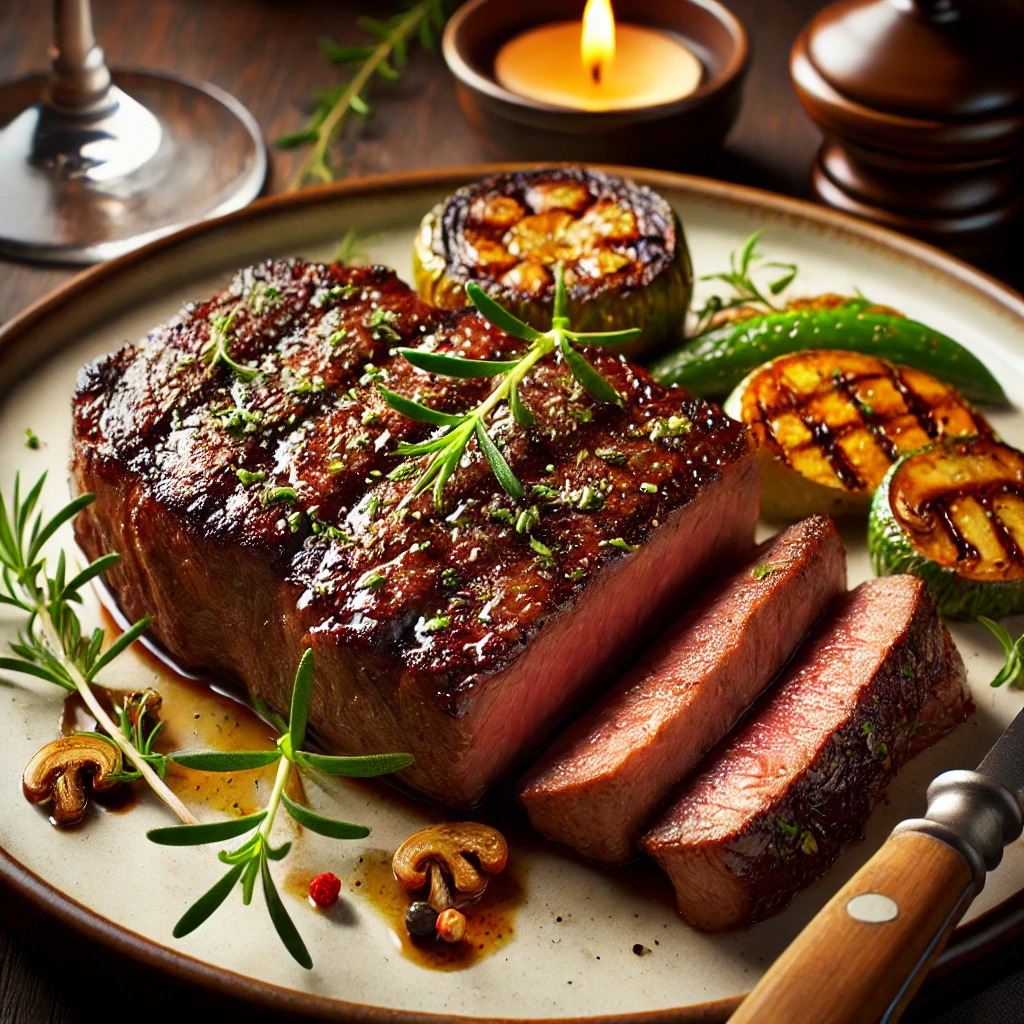Cooking the perfect steak is an art that combines technique, timing, and quality ingredients. Whether you prefer your steak rare, medium, or well-done, achieving that perfect balance of flavor, tenderness, and juiciness requires some insider knowledge. In this guide, we share tips and secrets from professional chefs to help you cook the perfect steak at home.
Choosing the Right Cut
Understanding Steak Cuts
Different cuts of steak offer unique flavors and textures. Here are some popular options:
- Ribeye: Known for its rich marbling and tenderness, ribeye is a flavorful choice.
- Filet Mignon: This cut is exceptionally tender with a mild flavor, making it a premium choice.
- New York Strip: A balance of tenderness and flavor, the New York strip is a favorite among steak enthusiasts.
- T-Bone/Porterhouse: These cuts combine the filet and strip, offering a variety of textures and flavors in one steak.
Selecting Quality Meat
Look for steaks with good marbling, as the fat content enhances flavor and juiciness. Choose USDA Prime or Choice grades for the best quality. Fresh, high-quality meat is crucial for achieving a perfect steak.
Preparation and Seasoning
Bringing the Steak to Room Temperature
Before cooking, let your steak sit at room temperature for about 30-60 minutes. This ensures even cooking and helps achieve the desired doneness.
Seasoning the Steak
Simple seasoning often yields the best results. Generously coat both sides of the steak with kosher salt and freshly ground black pepper. You can also add garlic powder, onion powder, or herbs like rosemary and thyme for extra flavor.
Cooking Techniques
Pan-Seared Steak
Ingredients:
- 1 steak (ribeye, filet mignon, New York strip, or T-bone)
- Kosher salt
- Freshly ground black pepper
- 2 tablespoons high-smoke point oil (e.g., canola or grapeseed oil)
- 2 tablespoons unsalted butter
- 2-3 garlic cloves, crushed
- Fresh rosemary or thyme sprigs
Instructions:
- Preheat the Pan: Heat a cast-iron skillet over high heat until it’s extremely hot.
- Season the Steak: Season the steak with salt and pepper.
- Sear the Steak: Add oil to the hot skillet. Place the steak in the skillet and sear for 2-3 minutes per side until a brown crust forms.
- Add Butter and Aromatics: Reduce heat to medium. Add butter, garlic, and herbs to the pan. Spoon the melted butter over the steak to baste it.
- Check Doneness: Use a meat thermometer to check the internal temperature. Aim for 125°F (52°C) for rare, 135°F (57°C) for medium-rare, 145°F (63°C) for medium, 150°F (66°C) for medium-well, and 160°F (71°C) for well-done.
- Rest the Steak: Remove the steak from the pan and let it rest for 5-10 minutes to allow the juices to redistribute.
Grilled Steak
Ingredients:
- 1 steak (ribeye, filet mignon, New York strip, or T-bone)
- Kosher salt
- Freshly ground black pepper
- Olive oil
Instructions:
- Preheat the Grill: Heat the grill to high heat.
- Season the Steak: Drizzle the steak with olive oil and season with salt and pepper.
- Grill the Steak: Place the steak on the grill and cook for 4-5 minutes per side for medium-rare, adjusting time based on your preferred doneness.
- Rest the Steak: Remove the steak from the grill and let it rest for 5-10 minutes before serving.
Tips from Professional Chefs
1. Use a Meat Thermometer
A meat thermometer ensures precise cooking. Insert it into the thickest part of the steak to check the internal temperature without cutting into the meat.
2. Let the Steak Rest
Resting the steak after cooking allows the juices to redistribute, resulting in a more flavorful and juicy steak. Cover it loosely with foil during the resting period.
3. Don’t Overcrowd the Pan
When pan-searing, ensure the steak has enough space in the pan to develop a good crust. Overcrowding can cause the steak to steam rather than sear.
4. Experiment with Compound Butters
Enhance the flavor of your steak by serving it with compound butter. Mix softened butter with ingredients like garlic, herbs, and lemon zest, and place a dollop on top of the hot steak before serving.
5. Reverse Searing for Even Cooking
For thicker cuts, try the reverse sear method. Cook the steak in a low oven (around 275°F or 135°C) until it reaches the desired internal temperature, then sear it in a hot pan for a crispy exterior.
FAQs about Cooking the Perfect Steak
What is the best cut of steak for grilling?
Ribeye, New York strip, and T-bone steaks are excellent for grilling due to their marbling and flavor.
How do I know when my steak is done?
Use a meat thermometer to check the internal temperature: 125°F for rare, 135°F for medium-rare, 145°F for medium, 150°F for medium-well, and 160°F for well-done.
Why should I let my steak rest?
Resting the steak allows the juices to redistribute, making it more flavorful and juicy.
Can I use a non-stick pan for searing steak?
It’s better to use a cast-iron skillet or stainless-steel pan for searing, as they can withstand high heat and develop a better crust.
What’s the best way to season a steak?
Simple seasoning with kosher salt and freshly ground black pepper is often best. You can also add garlic powder, onion powder, or herbs for extra flavor.
How can I make my steak more tender?
Choose high-quality meat, cook it to the right temperature, and let it rest. Marinating and using a meat tenderizer can also help.
Conclusion
Cooking the perfect steak at home is achievable with the right techniques and a little practice. By choosing the right cut, seasoning well, and using proper cooking methods, you can create a restaurant-quality steak that’s tender, juicy, and full of flavor. Follow these tips from professional chefs to impress your family and friends with your steak-cooking skills.
Sources
- Steak Cooking Techniques – Serious Eats
- Grilling Tips – Bon Appétit
- Meat Thermometer Guide – The Spruce Eats
- Resting Meat Tips – Food Network
- Compound Butter Recipes – Epicurious
Master the art of cooking the perfect steak with these professional tips and techniques, ensuring every bite is delicious and satisfying.

